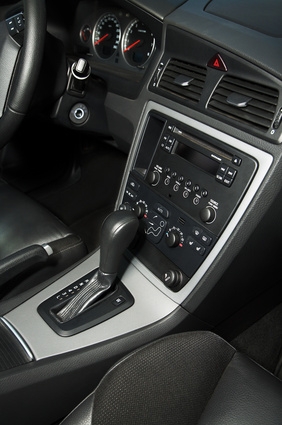
The job of a car transmission is to allow the engine to move forward (or backward) at various speeds using the power generated by the engine to run the whole affair. Today's modern cars have two design options for a transmission: automatic or manual. The automatic version does all the thinking for the driver, automatically shifting between gears as needed. The manual version relies on the driver to make gear-changing decisions. Deciding which transmission to have tends to be a personal choice, but there are some mechanical differences to be aware of.
The translation of power created by the engine to that used by a car transmission varies between an automatic and manual. Because an automatic works in set ranges of engine revolutions per minute before gear changing, the maximum output between gears can never be obtained. The engine changes gears before that happens. A manual transmission waits for the driver to make the change, and a good driver with experience knows exactly when the maximum output at each gear range is achieved. This in turn gets the most out of the engine production. When manual drivers say they "hear" the engine, they are referring to this process, listening to the engine power noise to tell them when to change gears.
Modern automatic transmissions have developed from sloppy affairs to very precise operating systems run by computers. However, a manual transmission with an experienced driver will still run faster than an automatic, again due to the driver knowing how to maximize engine power before gear-changing. Tests in the same model car can show a variance of as much as 2.4 seconds in favor of a manual transmission accelerating from 0 to 60 mph. This is a significant difference in engine speed.
There is no major gain in fuel difference between an automatic transmission and a manual transmission with city driving. Stop-and-go and short-hop commuting are just plain bad for any car and contribute to engines being insufficiently heated and residue buildup. Due to having to come to a full stop and then accelerate again many times, gas is wasted far more than on a regular cruise.
On long stretches on which the car can maximize its gear ratios, automatics tend to do better, but not by much. The differences aren't going to save significant amounts of money, such as an entire month's worth of gas. In most cases, the savings is only about one to two miles more per gallon in efficiency.
Automatic transmissions tend to win the award for transmission repair costs hands down in the first 80,000 to 100,000 miles. Because their design hadles gear-changing in a controlled environment, these transmissions don't suffer from human error. Assuming the proper transmission oil is used and changed regularly, and the engine is used correctly outside of extreme climates, automatic transmissions can last significantly longer than manual transmissions on average.
Manual transmissions are more prone to repair because of the human factor being implemented through the clutch. Clutch wear and burnout tend to be the most common repair issues. The ball that the manual hand lever operates around while switching gears also tends to disintegrate.
Cost-wise however, manual transmissions seem to cost less in total repairs. An automatic transmission repair, when it does go bad, usually requires a full rebuild, with a significant charge for labor involved.
Choice is where the automatic versus manual preference gets personal. You have to decide whether you want to be thinking about what your car does as you drive it, or if you just want to push the gas pedal and go forward. For those looking for serious power feel and response, a manual transmission will be the way to go. For those who just need transportation, an automatic will work just fine.